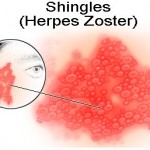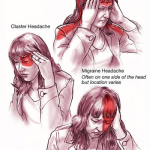Postherpetic Neuralgia
Postherpetic neuralgia is defined as pain that persists for 1-6 months after an acute herpes zoster infection.
 Pain is neuropathic;
Pain is neuropathic;- Pain is associated with hyperalgesia (increased sensitivity) that typically affects the V1 distribution of the trigeminal nerve;
- Postherpetic neuralgia follows a known herpes zoster infection; and
- The treatment is pharmacologic: antidepressants (tricyclics and selective serotonin reuptake inhibitors) and anticonvulsants.
Temporomandibular Joint Syndrome
Temporomandibular joint (TMJ) syndrome is a malfunction of the TMJ that controls the jaw, leading to facial pain. Characteristics of TMJ syndrome include:
- Tenderness over either joint that is aggravated by eating, speaking, and chewing gum; and
- Pain is dull, crushing, or burning and often radiates to the ear or the side of the head.
TMJ syndrome has numerous etiologies related to dental problems and chewing:
- Gum chewing;
- Chewing on one side of mouth;
- Missing teeth, malocclusion;
- Grinding, clenching teeth;
and - Frequent intake of hard-to-chew foods (steak, bagels).
Treatment of TMJ syndrome may involve a multidisciplinary approach:
- Dental consult;
- Nonsteroidal anti-inflammatory medications (Ibuprofen);
- Warm packs to affected areas; and
- Relaxation exercises.
Cluster Headache
Cluster headache afflicts mostly young men. The pain of a cluster headache is an intense, unilateral, deep orbital pain that radiates
to the forehead, temples, cheek, neck, or ear.
- Pain most often occurs at night, beginning within 1-2 hours of sleep onset but can also occur during the day;
- Headache recurs daily for many weeks or months followed by a pain-free period;
- May be associated with conjunctival injection, tearing, and nasal congestion;
- Patients may pace the floor and even injure themselves as a result of pain severity; and
- Treatment of cluster headache may include oxygen therapy for abortive treatment, and verapamil, lithium, or divalproex sodium for prevention.
Migraine Headache
 Migraine headaches are more common than cluster headaches and may be either bilateral or unilateral.
Migraine headaches are more common than cluster headaches and may be either bilateral or unilateral.
- Pain has a throbbing quality, which may have an associated pulsatile sensation;
- There may be photophobia, phonophobia, and nausea;
- Pain worsens with exertion and improves with sleep; and
- There may be an aura preceding the headache.
Treatment of migraine headache may include serotonin agonists, ergotamine, or anti-inflammatory medications for abortive therapy. Anticonvulsants, beta-blockers, calcium channel blockers, antidepressants, and angiotensin receptor-blocking agents are prescribed for prevention of migraine headache.
Miscellaneous Types of Facial Pain
Other less common causes of facial pain include malignancy, vasculitis, and infection. Treatment is directed toward the underlying medical problem.
Persistent Idiopathic Facial Pain
 Persistent idiopathic facial pain (PIFP) affects both sexes, but women are more likely than men to seek care for this condition. PIFP mainly affects adults and is a diagnosis of exclusion.
Persistent idiopathic facial pain (PIFP) affects both sexes, but women are more likely than men to seek care for this condition. PIFP mainly affects adults and is a diagnosis of exclusion.
PIFP refers to pain along the trigeminal nerve that does not fit the classic presentation of other cranial neuralgias. The duration of the pain is usually long, lasting most of the day, and may be continuous. The pain is unilateral and may be described as a severe ache, crushing sensation, or burning sensation. Physical examination is within normal limits.
The International Headache Society’s definition of PIFC includes the following elements:
- Facial pain;
- Presents daily and persists all or most of the day;
- Confined at onset to a limited area on one side of the face, a deep ache that is poorly localized; and
- Not associated with sensory loss or other physical signs, and patient has normal laboratory/imaging studies.
Treatment of PIFP is primarily medical and includes anticonvulsants, tricyclic antidepressants, and topical analgesics such as
lidocaine gel or patch. Narcotic analgesics are not indicated and may cause a rebound pain syndrome. Acupuncture may also be helpful. If pain persists and is not relieved by medication, referral to a pain clinic is warranted. Other consultations may be indicated (dentist, neurologist, psychologist/social worker).
Difficulty in Diagnosis
Getting a correct diagnosis for your facial pain isn’t easy. People who have facial pain disorders often report that it has taken three to five years and visits to multiple physicians, for them to obtain a correct diagnosis. There are many reasons for this:
(1) The rarity of these disorders means that many physicians will have little experience with identifying these illnesses; many
physicians will not see even a single case of trigminal neuralgia in 40 years of practice.
(2) The dissimilarities of the disorders from person to person: Even among people who have “Type 1†or “Typical TNâ€, the most common form of the most common facial disorder, symptoms may be quite different from person to person.
(3) The mysterious tendency for these disorders to suddenly go into remission: People who suffer with neuropathic facial disorders may experience weeks, months or even years of sudden disappearance of their symptoms; and
(4) The imperfection of diagnostics: Unfortunately, a specific mechanism to reliably identify and differentiate between facial pain syndromes has not yet been discovered. Diagnosis is still a medical art, dependent upon the experience and knowledge of the examining physician.
Considering the difficulty in accurately diagnosing facial pain, you can see why people suffer for months or years before a diagnosis is made. Unfortunately, sometimes a specific diagnosis can never be made because of the complexities involved. Even when a specific diagnosis cannot be confirmed, however, facial pain can still be effectively managed for the majority of
patients.
Conclusion
The evaluation of a patient with facial pain is within the scope of primary care and advanced nursing practice. The patient may be in a great deal of pain and will need frequent reassurance and patient education, as well as appropriate pharmacologic and holistic treatments. Prompt consultation is essential for clients who do not rapidly respond to outlined treatment strategies.
